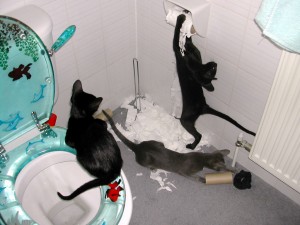My #FridayFlash short-short story, “Too Much Information,” this past week experimented with a different kind of conflict, something I’m calling “alternative conflict.” In reality, there are published stories out there, in prose and in TV and film, that already use conflict like this, so it really isn’t alternative. (It’s mainstream.) But the advice that you get as a novice writer frequently forbids you from exploring any but one form of conflict.
Traditional form dictates that you start with a character who has a problem, and that’s where the conflict in the story comes from. But in “Too Much Information,” the character has no problem. He (or she) explains that he has been dreaming the future, and he’s going to see if he can change the future by manipulating his dreams. Yes, he has a compelling need, to explore this dream phenomenon. But there’s no obstacle preventing him from meeting his need. Therefore, he has no problem. In fact, the entire story is about how he is meeting his need.
So then, if my character has no problem, how do I maintain the reader’s interest?
Indeed, many of the more literary short stories that I read, they focus on the beauty of the language, or they merely describe a character or a scene. They have no character problem, and they sometimes suffer from the travelogue syndrome. They don’t resemble anything that I would call a story (though there are other readers who do enjoy these pieces). And they fail to draw me in, because there’s no conflict.
When I wrote “Too Much Information,” however, I focused on the conflict, even though the character has no problem. I tried to draw readers in, firstly, with the idea that the character has his head in the clouds or is imagining some phenomenon that doesn’t exist. Then with the idea that he actually might be dreaming the future. As the story progresses, the reader should realize that the character is ascribing special meaning to mere coincidence, even though the character himself doesn’t see things that way. At that point, the conflict is resolved (because the “dreaming the future” has been explained away), and the story is over. So there is a story arc, but happens in the reader’s mind, rather than in the character’s experience. The character doesn’t change, but the reader’s perception does.
What Is Conflict?
One standard definition is that conflict occurs when a character has a problem. And this is true: if you create a character and give him a compelling problem, you will have a compelling story conflict.
But are there other ways to generate conflict? I believe so. And we can discover what they are with a better definition, a definition that tells us what conflict is beyond a character’s problems.
Holly Lisle, I think, comes very close in her excellent How to Write Page-Turning Scenes, with a profound insight: “Conflict is, simply put, change. Anytime something changes, it creates ripples that will be good for some people, bad for others.” She then goes on to detail five categories of conflict that she has identified in her experience as a fiction author.
I think Holly’s definition comes darn close. And as a metaphor, it’s perfect. But I would refine it one more step further. Conflict is not change, but conflict always goes along with change. The only way to produce conflict is to divert from the status quo, that is, to change something. And the only way to resolve conflict is through change, to move to a new status quo. So change precedes conflict, and change follows conflict. And thickening the plot also is a form of change, a transmutation of conflict, from a lesser conflict to a greater conflict.
So I would define conflict as follows:
Conflict is a perception by the reader that compelling change has occurred and will occur.
That’s what I tried to do in my story, to indicate to the reader that something was off from the status quo (that the laws of the universe had changed from what he understood), with the implicit promise that I was going to explain this discrepancy (thus producing a new status quo).
Thursday’s post will explore some more stories that use alternative conflict. (UPDATE: Click here to read it.)
In the meantime…
Keep writing!
-TimK

Leave a Reply